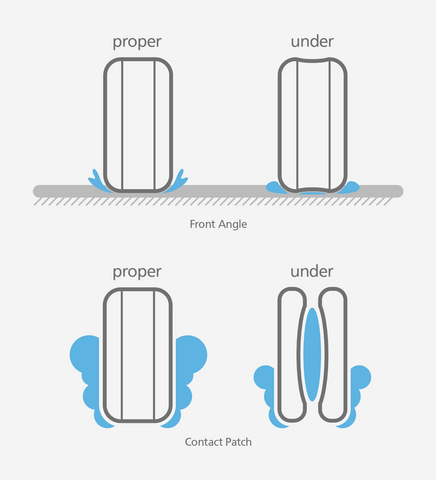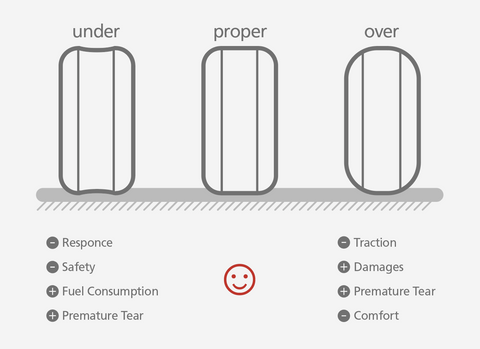Are you someone who loves to save a bit on gas? Do you hate it when you suddenly have a flat tire, wait for the road assistance and just mess up the whole day? Is tire skidding something of which you are scared? At least I am.
When it comes to driving safety & fuel economy, your tire condition is always one of the crucial factors. Why does tire pressure matter? How often should I check my tire pressure? How does tire pressure affect my driving experience? Should I rotate my tires and when? We got tons of questions from our community, and we thought it's entirely necessary for us to put together an article and solve them all. So, here we go.
TIRE MAINTENANCE 101
1 IMPORTANCE OF TIRE PRESSURE
In a nutshell, your tire pressure would have effects on the following things
- Grip & Hydroplaning
The grip is mostly associated with the size of the contact patch between the tire and the road. An over-inflated tire radically decreases the contact patch while an under-inflated tire does the opposite.
A larger contact patch (meaning an under-inflated tire) gives you more grip, and this is the exact reason why lots of racers will intentionally decrease their tire pressures to create a larger contact patch on a dry race track.
However, for daily commuters, it's NOT recommended to under-inflate your tire for more grip given you are not on a dry race track, and you are not racing. Not only would an under-inflated tire increase your fuel consumption which we will cover later, cause an uneven tear and wear, but also increase the chance of hydroplaning.
Hydroplaning is a hazardous event when a layer of water builds between the wheels and the road surface, leading to a loss of traction that prevents the vehicle from responding to control inputs. It occurs when the pressure of the tire putting on the ground is equal to the water pushing back up on that tire. The larger the contact patch (by deflating the tires), the less pressure it puts on that same area. So there's a causal relationship between your tire pressure and the possibility of a hydroplaning event.
Here's a more visual explanation of what is happening between a properly-inflated tire and an underinflated tire when driving on a wet road.

- Fuel Economy
Imagine you are a ball rolling on the ice, there's no friction between the two surfaces, how much extra forces do you need to apply to keep the ball moving? Zero (Thanks, Newton). Same applies to your fuel consumption when it comes to driving on the road. The rolling resistance between your tires and road significantly affects the fuel economy, and by now we should all know the logic behind this, lower tire pressure leads to larger the contact patch, which causes higher rolling resistance, and thus, poor fuel economy.

A Michelin study showed that your tire is accountable for at least 1/5 of your total fuel consumption and a 1-bar of pressure drop (14.5 psi) would increase your fuel consumption by 3-5%.
- Tear and wear
The contact patch directly decides the pattern of the tire's tear and wear. You don't want your tires to wear out prematurely just because you have an over or under-inflated tire. It might cause a loss of up to 60% of your tire longevity, and you know how expansive those tires are.

Overall, different tire pressure causes changes in your tire's performance, even though you can manipulate them to fit your specific needs, as a daily commuter, we strongly suggest you keep your tires properly inflated.

If you'd like to have a deeper understanding of the underlying theories behind all those facts, check this article in which we had a more technical analysis of the topic.
2 TIRE MAINTENANCE TIPS 101
It might seem overwhelming at first glance, but doing those things can benefit you greatly.
- Check Your Tire Pressure Regularly and Keep Them Properly Inflated.
It is recommended that you check your tire pressure at least once every week, and every time before you'd have a long road trip. You can use a tire pressure gauge if you want to get a bit more hands-on and keep yourself disciplined, or you can install an advanced Tire Pressure Monitor like what we have built here at nonda, so you always know precisely what your tire pressure is just by opening your ZUS app.
- Inspect Your Tires for Potential Problems.
According to Michelin, you should examine your tires thoroughly once every month, and of course, every time before you go on a long trip.
Besides tire pressure, you should also inspect on two things.
Tear and wear by the tread depth
If you have a tread depth gauge, that's the perfect tool to use. If not, the easiest way to see if your tread depth is okay or not is to use a penny and stuck it in the tread like the picture.

If any part of Lincoln's head is covered, then you are still driving with enough tread. Do NOT drive when the tread goes below that level, it reduces the grip dramatically, and your chances of an accident would skyrocket.
Physical damage
Look for any visible physical damage and ask for professional help when you find some problems with your tires. Repair them promptly, or you'll have no choice but to replace the tires.
- Rotate Your Tire
No matter if your car is FWD, RWD, or AWD, each tire will wear differently from handling different weights and supporting various functions. Regular rotation helps extend the lifespan of your tires and improve performance by evening out the wear of four tires.
If you like to boost your driving safety and save money, you should always rotate your tires every 6,000-8,000 miles according to Michelin or check your driver's manual for more specific instructions.
Based on your vehicle's model, this is how you should rotate your tires.

- Change your tires when necessary
Nowadays, the tires are built to last for 40,000-50,000 miles from proper use and care. Yet the lifespan of a tire depends on a combination of factors: how you drive, how you take care of your tires, the road condition, the climate, etc.
It is empirical to remember those rule of thumbs according to Michelin.
1) After five years in use, your tires should be thoroughly inspected by a professional to check its usability.
2) Ten years is the maximum lifespan of a tire.
3) When the tread is too shallow, it's time to change the tire.
4) Physical damages on tires can cause serious problems, check with a professional to see if it can be repaired or have to be replaced.
3 BENEFITS OF KEEPING YOUR TIRE CHECKED
Overall, it's incredibly crucial to keep your tires under optimal condition, which would bring you lots of benefits including:

Want an easy way to keep an eye on your tires' condition? Check out our award-winning ZUS Smart Tire Safety Monitor, used and supported by hundreds of thousands of our users, you'll love the functions and peace of mind it brings to you.










2 comments
Feb 10, 2020 • Posted by Jason
This is Amazing!!
Mar 20, 2019 • Posted by Tony Trayvilla
In a regular air presure of the tire, is it appropriate to maintain tire air @35&40 psi in the front&rear respectively as what i have did fr the past 3 years?pls.expound more on this. This issue is very educational, thank you!
Leave a comment